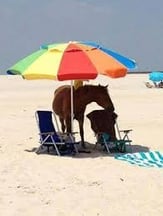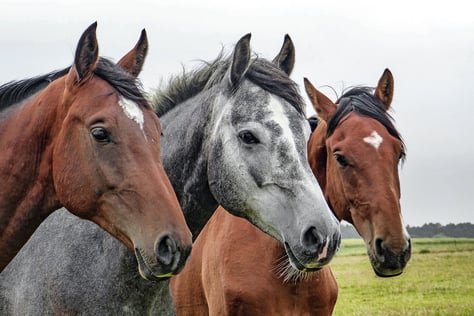 With summer now officially here, you know it makes good sense for you to be careful in the sun with adequate coverage and sunscreen. But it's also important to check your horse for signs of sunburn and learn how to avoid problems.
With summer now officially here, you know it makes good sense for you to be careful in the sun with adequate coverage and sunscreen. But it's also important to check your horse for signs of sunburn and learn how to avoid problems.
Sunburn occurs from too much exposure to the sun without proper covering or protection. It can be caused by a side effect to some drugs, like tetracycline, that cause photosensitivity. Light-colored horses and horses with white markings can get quite badly sunburned without proper care. This occurs especially on the muzzle and around the eyes. Dark-coated, dark-skinned horses usually are not as prone to sunburn, but can experience a certain amount of bleaching of their coat. The most common is that a black coat suddenly turns red.
Since it’s always easier to prevent something than to treat it, here are some suggestions to safeguard your horse against sunburn.
- Covering your horse with a fly sheet not only protect against flies, but also from the harmful rays of the sun. The fly sheet has tiny holes that allow air to circulate so he doesn’t get too warm.
- Use a fly mask, especially one that covers both his ears and all the way down to the tip of the muzzle. Many horses have white blazes and snips – anywhere the coat is white with a pinkish tint showing is susceptible to burning.
- Use a sun screen product on your horse. While it is best to use sunscreen products especially made for horses, it is also possible to use sunscreen for humans on your horse. To be safe, use the ones designed for sensitive skin.
- Apply sunscreen ½ hour before going in the run and reapply any sun screen products every two hours to maintain its strength. There are some colored sunscreens that will help you see if the product needs to be reapplied. For example, if your horse has been grazing on wet grass, the sunscreen on his nose can easily be washed away.
- You can also use fly spray that contains sunscreen to prevent sunburn as well as control pests.
- Use shampoos and conditioners with sun screen as well.
- Limit your horse’s time in the sun, especially 12-3pm when the sun is typically strongest.
- Offer shade for your horse to get out of the sun, e.g. trees, a run in shed, etc.
- If you’re going on a trail ride, select a shady route.
- Turn out your horse at night and keep him out of the sun during the day.
Remember that sun burn can occur even on cloudy days so take the same precautions even when the sun isn’t shining. If your horse does become sunburned, protect it from further sun exposure and try to keep the area as clean to prevent infection. You can use sunburn relief products like aloe to help reduce pain and keep the skin moist to avoid peeling. Antiseptic ointments also work to protect and help heal. If blisters or some other skin condition develops, it’s best to check with your vet to make sure there’s not some other problem at work.
Watching out for harmful sun rays is important for both you and your horse!
<span style="color:#000000;">Photo credit: Tuesday's Horse</span>



